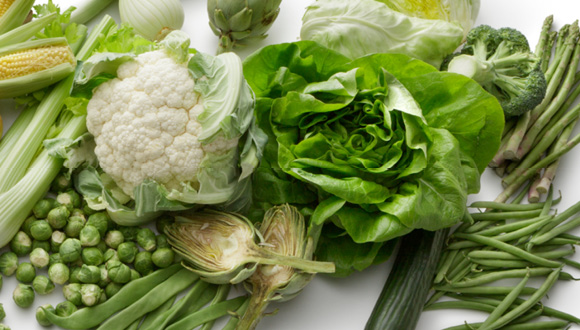Clean Eating: Why You Should Consider "Going Green" With Your Diet
Oct. 9, 2019 - Sheshe GiddensIf we are honest, most will admit that our daily diet isn’t ideal. We eat too much sugar, red meat and fried foods. We don’t get enough fruits and vegetables.
And, when we do eat fruits and vegetables, we often prepare them in ways that completely defeats the purpose. (Related: 5 Common Veggie Mishaps & How to Avoid Them)
If you want to clear the clutter from your diet, it’s time to try eating clean.
What is clean eating and why is it good for you?
Just like cleaning up the planet, going green can help clean up your diet. Eating clean means eliminating ultra-processed foods and embracing whole foods like fruits and vegetables.
“Eating clean refers to selecting mostly whole, minimally prepared plant-based foods while limiting intake of ultra-processed packaged foods that contain multiple ingredients and excessive amounts of added sugar and salt,” says Kari Kooi, a clinical dietitian specialist IV at Houston Methodist. “The more processing a food undergoes from its original form, the less nutritional value it contains.”
Eating clean and eating raw aren’t the same thing. Cooking some foods actually helps breakdown vegetables’ tough cell structures that make them harder for us to digest. The key is to prepare foods in a way that preserves most of their nutrients.
Remember these cooking techniques: steam, roast, bake, grill, sauté, and, if necessary, microwave. Avoid frying, boiling and smothering your food.
Also, fresh and frozen fruits and vegetables are preferred over canned as canned produce often contains added sugar and salt. Frozen produce can be more nutrient-dense than fresh produce thanks to the flash freezing process where the nutrients get locked in. (Related: Are Canned & Frozen Veggies As Healthy As Fresh Ones?)
5 foods to consider if you need help "going green"
Although you should still explore the rainbow of colors when eating fruits and vegetable, green is the color more closely associated with life, health, nature and renewal. A change in your food’s color palette is a great way to shake things up.
Here are five foods to get you started:
1. Asparagus
Looking for a natural anti-ager? Emerging in the springtime, these green spears offer a bounty of nutrients. Asparagus is high in glutathione, an antioxidant that can help reduce skin damage from the sun. Additionally, asparagus contains the most folate of any vegetable. Folate plays a vital role in heart health and the prevention of birth defects.
Asparagus is in season during the spring. Choose stalks with dry tight tips. Wrap them in a damp paper towel and store them in a plastic bag in the refrigerator for up to four days. Dress asparagus with a little olive oil, salt and pepper before grilling, steaming or roasting it.
Recipes to try:
2. Avocado
Add some thin slices of smooth avocado to your sandwich or salad without feeling guilty.
The monounsaturated fat in avocado is what’s mostly responsible for avocado’s super food status. This type of “happy fat” can help drive down levels of bad cholesterol. It is also good for your heart, skin and joints. (Related: Is Avocado Toast Actually Healthy?)
For a ready to eat, ripe avocado, choose a firm one that only has a slight give when you press on it. If the avocado is hard, leave it on the counter for a few days to ripen. Ripe avocados can be stored in the refrigerator for up to five days.
Recipes to try:
3. Brussels sprouts
These baby cabbages are loaded with antioxidants and filling fiber. A cruciferous vegetable, Brussels sprouts contain powerful, cancer-fighting sulfur compounds that are responsible for their pungent aroma. These green jewels take on a whole new flavor and crispy texture when roasted in the oven.
To avoid bitter sprouts, roast them in the oven or sauté the on the stove. Don’t boil them. Carmelization is key tasty Brussels sprouts.
How to perfectly roast Brussels sprouts:
4. Kale
Did you know kale is a better source of calcium than spinach? This is due to its lower levels of oxalic acid.
This beautiful ruffled green is being called “the queen of greens.” Kale is brimming with eye-nourishing carotenoids, lutein and zeaxanthin, a pair of phytochemicals shown to prevent macular degeneration and cataracts. (Related: Eye Health: 3 Tips for Protecting Your Vision)
Kale is high in vitamin K, so if you are taking blood thinners, be careful about how much kale you eat. Also, raw kale can be difficult to digest in large amounts.
Recipes to try:
5. Kiwifruit
Rich in vitamin C, potassium and fiber, kiwis make a perfectly portable snack. (Related: Why Getting Vitamin C Through Your Diet is Important)
Just slice a kiwi in half and scoop out the emerald flesh with a spoon. You will dazzle your body with nutrients. This sweet and tart fruit has a unique taste, with flavors reminiscent of strawberry, banana, melon, pineapple and citrus.
To select a tasty, ripe kiwifruit, select one that is firm using your thumb to apply a little pressure. If it gives slightly, it is ready to eat.
Recipe to try:


